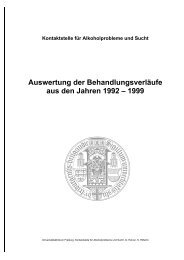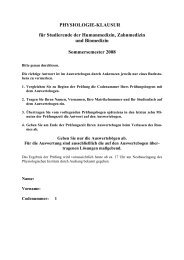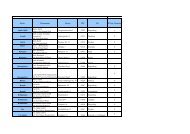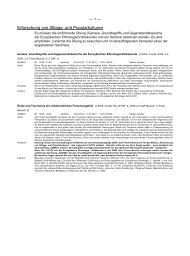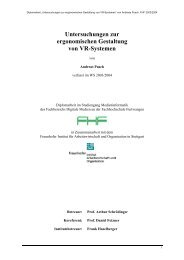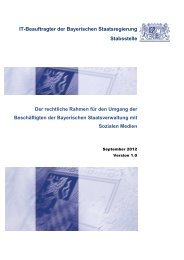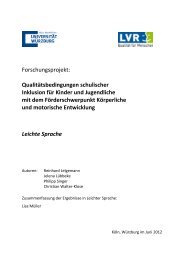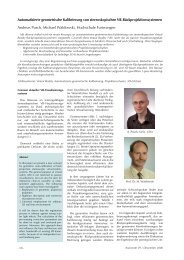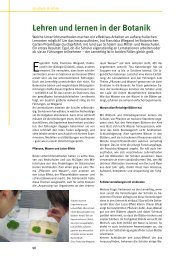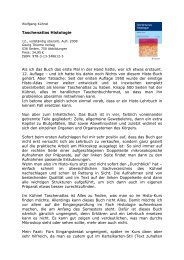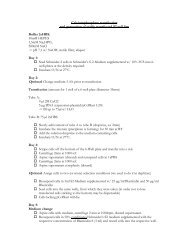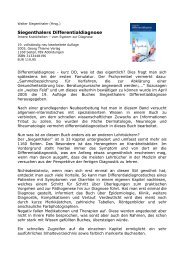Effects of Hand Feedback Fidelity on Near Space Pointing ...
Effects of Hand Feedback Fidelity on Near Space Pointing ...
Effects of Hand Feedback Fidelity on Near Space Pointing ...
You also want an ePaper? Increase the reach of your titles
YUMPU automatically turns print PDFs into web optimized ePapers that Google loves.
<str<strong>on</strong>g>Effects</str<strong>on</strong>g> <str<strong>on</strong>g>of</str<strong>on</strong>g> <str<strong>on</strong>g>Hand</str<strong>on</strong>g> <str<strong>on</strong>g>Feedback</str<strong>on</strong>g> <str<strong>on</strong>g>Fidelity</str<strong>on</strong>g><br />
<strong>on</strong> <strong>Near</strong> <strong>Space</strong> <strong>Pointing</strong> Performance and User Acceptance<br />
1, 4<br />
Andreas Pusch<br />
INRIA Grenoble Rhône-Alpes – LIG<br />
655, av. de l'Europe<br />
38334 St. Ismier Cedex, France<br />
ABSTRACT 12345<br />
In this paper, we report <strong>on</strong> an experiment c<strong>on</strong>ducted to test the<br />
effects <str<strong>on</strong>g>of</str<strong>on</strong>g> different hand representati<strong>on</strong>s <strong>on</strong> near space pointing<br />
performance and user preference. Subjects were presented with<br />
varying levels <str<strong>on</strong>g>of</str<strong>on</strong>g> hand realism, including real hand video, a high<br />
and a low level 3D hand model and an ordinary 3D pointer arrow.<br />
Behavioural data revealed that an abstract hand substitute like a<br />
3D pointer arrow leads to significantly larger positi<strong>on</strong> estimati<strong>on</strong><br />
errors in terms <str<strong>on</strong>g>of</str<strong>on</strong>g> lateral target overshooting when touching<br />
virtual surfaces with <strong>on</strong>ly visual hand movement c<strong>on</strong>straints.<br />
Further, questi<strong>on</strong>naire results show that a higher fidelity hand is<br />
preferred over lower fidelity representati<strong>on</strong>s for different aspects<br />
<str<strong>on</strong>g>of</str<strong>on</strong>g> the task. But we cannot c<strong>on</strong>clude that realtime video feedback<br />
<str<strong>on</strong>g>of</str<strong>on</strong>g> the own hand is better rated than a high level static 3D hand<br />
model. Overall, these results, which largely c<strong>on</strong>firm previous<br />
research, suggest that, although a higher fidelity feedback <str<strong>on</strong>g>of</str<strong>on</strong>g> the<br />
hand is desirable from an user acceptance point <str<strong>on</strong>g>of</str<strong>on</strong>g> view, motor<br />
performance seems not to be affected by varying degrees <str<strong>on</strong>g>of</str<strong>on</strong>g> limb<br />
realism – as l<strong>on</strong>g as a hand-like shape is provided.<br />
Index terms: H.1.2 [Models and Principles]: User/Machine<br />
Systems---Human Factors; H.5.1 [Informati<strong>on</strong> Interfaces and<br />
Presentati<strong>on</strong>]: Multimedia Informati<strong>on</strong> Systems---Artificial,<br />
Augmented, and Virtual Realities; I.3.6 [Computer Graphics]:<br />
Methodology and Techniques---Interacti<strong>on</strong> Techniques<br />
Additi<strong>on</strong>al keywords: <strong>Near</strong> space interacti<strong>on</strong>, co-locati<strong>on</strong>, limb<br />
attributi<strong>on</strong>, percepti<strong>on</strong>, video see-through head-mounted display,<br />
hand displacement, visuo-proprioceptive sensory c<strong>on</strong>flict<br />
1 andreas.pusch@imag.fr<br />
2 olivier.martin@ujf-grenoble.fr<br />
3 sabine.coquillart@inria.fr<br />
4 Currently working at:<br />
IIHM – UJF – LIG, 110, av. de la Chimie – BP 53,<br />
38041 Grenoble Cedex 9, France<br />
5 Currently working at:<br />
GIPSA-lab – UJF, 961, rue de la Houille Blanche –<br />
BP 46, 38402 Grenoble Cedex, France<br />
2, 5<br />
Olivier Martin<br />
INRIA Grenoble Rhône-Alpes – LIG<br />
655, av. de l'Europe<br />
38334 St. Ismier Cedex, France<br />
1 INTRODUCTION<br />
Sabine Coquillart 3<br />
INRIA Grenoble Rhône-Alpes – LIG<br />
655, av. de l'Europe<br />
38334 St. Ismier Cedex, France<br />
Object selecti<strong>on</strong> is a frequent task in human-computer interacti<strong>on</strong>.<br />
In particular, when interacting with 3D user interfaces, visi<strong>on</strong> <str<strong>on</strong>g>of</str<strong>on</strong>g><br />
the own hand or its representati<strong>on</strong> plays a decisive key role in the<br />
c<strong>on</strong>text <str<strong>on</strong>g>of</str<strong>on</strong>g> an intuitive direct c<strong>on</strong>trol. The “feeling <str<strong>on</strong>g>of</str<strong>on</strong>g> ownership <str<strong>on</strong>g>of</str<strong>on</strong>g><br />
a limb” [1, 2] helps to understand perceived acti<strong>on</strong>s as selfgenerated,<br />
since they typically match sensory feedback patterns<br />
predicted by the internal model <str<strong>on</strong>g>of</str<strong>on</strong>g> acti<strong>on</strong> [3]. The hand<br />
representati<strong>on</strong> may appear faithful / reliable, if it exhibits<br />
biologically plausible moti<strong>on</strong>s [4, 5] and a natural / familiar look<br />
[6, 7]. A higher fidelity visual hand feedback has further been<br />
shown to lead to a str<strong>on</strong>ger visuo-proprioceptive integrati<strong>on</strong> [8]<br />
and to reveal shorter reacti<strong>on</strong> and movement times compared to a<br />
lower fidelity hand feedback [9]. In a recent study, the<br />
effectiveness <str<strong>on</strong>g>of</str<strong>on</strong>g> the rubber hand illusi<strong>on</strong> [10], when invoked in<br />
Virtual Reality (VR), depended also <strong>on</strong> visual limb faithfulness<br />
[11]. Another important prerequisite for a perceptually c<strong>on</strong>vincing<br />
interacti<strong>on</strong> within hand's reach is co-locati<strong>on</strong>. This noti<strong>on</strong> refers to<br />
the spatial visual and proprioceptive alignment <str<strong>on</strong>g>of</str<strong>on</strong>g> an interacting<br />
limb. A qualitatively and quantitatively beneficial direct c<strong>on</strong>trol<br />
[12, 13] is c<strong>on</strong>veyed as well as a str<strong>on</strong>ger sense <str<strong>on</strong>g>of</str<strong>on</strong>g> presence [14].<br />
The resulting self attributi<strong>on</strong> [10] supports the natural c<strong>on</strong>tinuous<br />
observati<strong>on</strong> and correcti<strong>on</strong> loop resp<strong>on</strong>sible for compensating for<br />
pointing errors and / or target modificati<strong>on</strong>s [15], also in VR<br />
settings [16].<br />
We have set up an experiment <strong>on</strong> top <str<strong>on</strong>g>of</str<strong>on</strong>g> a system similar to<br />
the <strong>on</strong>e used in [17]. It is essentially based <strong>on</strong> a tracked (i.e., head<br />
and hand optically tracked at 6 degrees <str<strong>on</strong>g>of</str<strong>on</strong>g> freedom) Augmented<br />
Virtuality (AV) envir<strong>on</strong>ment using a video see-through (VST, 640<br />
x 480 video resoluti<strong>on</strong>) head-mounted display (HMD, 800 x 600<br />
display resoluti<strong>on</strong>). This c<strong>on</strong>figurati<strong>on</strong> permits to c<strong>on</strong>trol the 3D<br />
locati<strong>on</strong> <str<strong>on</strong>g>of</str<strong>on</strong>g> the live stereo video feedback <str<strong>on</strong>g>of</str<strong>on</strong>g> the hand embedded<br />
into an otherwise virtual scene by displacing the carrier objects<br />
textured with the captured image data. In our study, we will focus<br />
<strong>on</strong> subjective user preference and objective behavioural effects <str<strong>on</strong>g>of</str<strong>on</strong>g><br />
different levels <str<strong>on</strong>g>of</str<strong>on</strong>g> hand representati<strong>on</strong>s during pointing-like near<br />
space interacti<strong>on</strong> / selecti<strong>on</strong>.<br />
2 HYPOTHESES<br />
It has been stated in different studies that subjects <str<strong>on</strong>g>of</str<strong>on</strong>g>ten preferred<br />
hand representati<strong>on</strong>s at higher visual fidelity levels. This is an<br />
important fact from an user-centred design / interacti<strong>on</strong><br />
erg<strong>on</strong>omics viewpoint. But the degree <str<strong>on</strong>g>of</str<strong>on</strong>g> realism has rarely been<br />
assessed, in particular regarding the c<strong>on</strong>text <str<strong>on</strong>g>of</str<strong>on</strong>g> this paper.<br />
Hypothesis 1 focusses <strong>on</strong> the objective influence <str<strong>on</strong>g>of</str<strong>on</strong>g> the level<br />
<str<strong>on</strong>g>of</str<strong>on</strong>g> hand representati<strong>on</strong>s <strong>on</strong> behaviour in a goal-directed pointing<br />
task. With respect to related studies, we expect that the higher the<br />
fidelity <str<strong>on</strong>g>of</str<strong>on</strong>g> the hand feedback the more robust is limb attributi<strong>on</strong> /<br />
perceptual reliance (i.e., perceptual link to the corresp<strong>on</strong>ding<br />
limb). Motor performance should thus improve compared lower<br />
fidelity representati<strong>on</strong>s. More precisely, first, better final pointing<br />
stability is assumed, if the realism level <str<strong>on</strong>g>of</str<strong>on</strong>g> the hand feedback<br />
increases (i.e., towards the own hand). Stability is c<strong>on</strong>sidered an<br />
accuracy measure indicating the stimuli integrati<strong>on</strong> performance
<str<strong>on</strong>g>of</str<strong>on</strong>g> the sensorimotor system. Sec<strong>on</strong>d, we think that an intuitive<br />
feeling <str<strong>on</strong>g>of</str<strong>on</strong>g> c<strong>on</strong>trol can further be reflected by the extent <str<strong>on</strong>g>of</str<strong>on</strong>g> virtual<br />
object penetrati<strong>on</strong> with the real hand while the visual hand rests<br />
<strong>on</strong> the object's surface. That is, higher feedback fidelity may lead<br />
to less target overshooting until the detecti<strong>on</strong> <str<strong>on</strong>g>of</str<strong>on</strong>g> the touching<br />
event.<br />
Hypothesis 2 addresses effects <strong>on</strong> the subjective experience<br />
during virtual object touching within hand's reach. In agreement<br />
with previous research <strong>on</strong> VR limb realism and sense <str<strong>on</strong>g>of</str<strong>on</strong>g> presence,<br />
we expect that a high level representati<strong>on</strong> such as stereo video<br />
feedback <str<strong>on</strong>g>of</str<strong>on</strong>g> the own hand will be preferred over other classical<br />
hand representati<strong>on</strong>s or avatars (i.e., detailed 3D hand model,<br />
simplified 3D hand model and ordinary 3D pointer arrow, see<br />
Fig. 1). This advantage should hold for different aspects <str<strong>on</strong>g>of</str<strong>on</strong>g> a<br />
virtual surface touching scenario, including hand visualisati<strong>on</strong><br />
quality, final pointing accuracy, hand movement naturalness and<br />
overall comfort. User acceptance may decrease with lower hand<br />
realism levels.<br />
Figure 1: <str<strong>on</strong>g>Hand</str<strong>on</strong>g> representati<strong>on</strong>s used during the experiment<br />
(i.e., upper left: Video feedback, upper right: Detailed 3D model,<br />
lower left: Simplified 3D model, lower right: 3D pointer model).<br />
Reaching durati<strong>on</strong> and hand trajectory length will be observed<br />
as well between the moments where the hand enters the field <str<strong>on</strong>g>of</str<strong>on</strong>g><br />
view and actually reaches the target. These measures may be<br />
indicators for acti<strong>on</strong> optimisati<strong>on</strong> and ec<strong>on</strong>omics. However, the<br />
effective hand viewing space <str<strong>on</strong>g>of</str<strong>on</strong>g> the VST HMD used in the<br />
experiment is rather small (i.e., about 43 degrees horiz. and 27<br />
degrees vert.). C<strong>on</strong>sidering the relatively short visible hand<br />
transport phase from the rest positi<strong>on</strong> to the targets, effects may<br />
be marginal, but yet insightful.<br />
3 SUBJECTS<br />
Sixteen adult volunteers (i.e., 20 – 40 years old, 7 female, 9 male)<br />
participated in the study. N<strong>on</strong>e <str<strong>on</strong>g>of</str<strong>on</strong>g> them reported serious visi<strong>on</strong><br />
problems (i.e., either normal or corrected to normal visi<strong>on</strong>). A few<br />
subjects had some prior n<strong>on</strong>-expert knowledge <strong>on</strong> Augmented<br />
Reality (AR), AV, VR and / or human percepti<strong>on</strong>. All were naive<br />
about the study's purpose and had never used the experimental<br />
setup.<br />
4 METHODS<br />
In this secti<strong>on</strong>, we will present the experiment's factorial design,<br />
the pointing task to be performed, the administered questi<strong>on</strong>naire,<br />
as well as all relevant details <strong>on</strong> the data acquisiti<strong>on</strong> and analysis.<br />
4.1 Factorial design<br />
The experiment followed a 4 x 2 factorial design <str<strong>on</strong>g>of</str<strong>on</strong>g> which factor<br />
<strong>on</strong>e specifies the number <str<strong>on</strong>g>of</str<strong>on</strong>g> hand representati<strong>on</strong>s (see Fig. 1) and<br />
factor two the number <str<strong>on</strong>g>of</str<strong>on</strong>g> pointing target locati<strong>on</strong>s <strong>on</strong> a cube<br />
surface (see Fig. 2).<br />
All 3D hand models, including the arrow, had a comm<strong>on</strong><br />
visual appearance in terms <str<strong>on</strong>g>of</str<strong>on</strong>g> size and a uniform skin-like<br />
shading. Additi<strong>on</strong>ally, they were displayed at six degrees <str<strong>on</strong>g>of</str<strong>on</strong>g><br />
freedom according to the real hand tracking. The given video-tovirtual-world<br />
lag <str<strong>on</strong>g>of</str<strong>on</strong>g> about 50 ms was simulated for the purely<br />
virtual scenes.<br />
To prevent fast hand movement adaptati<strong>on</strong>, we decided to use<br />
more than <strong>on</strong>e target locati<strong>on</strong>. Two sufficiently separated targets<br />
(i.e., top near and bottom far, 3 cm edge length, see Fig. 2, right)<br />
were expected to meet this requirement. However, advanced<br />
behavioural analyses may also be possible when varying the<br />
target characteristics in this manner.<br />
Figure 2: Virtual scene (left, cube: 20 cm edge length),<br />
with target locati<strong>on</strong>s (right).<br />
In sum, there were eight c<strong>on</strong>diti<strong>on</strong>s which had to be randomly<br />
distributed and equally weighted over the durati<strong>on</strong> <str<strong>on</strong>g>of</str<strong>on</strong>g> the<br />
experiment to avoid any effect carry over. An 8 x 8 random latin<br />
square was generated to assure balanced trial sets. Each<br />
participant had to perform 16 repetiti<strong>on</strong> per c<strong>on</strong>diti<strong>on</strong> making up<br />
128 trials in total.<br />
4.2 <strong>Pointing</strong> task<br />
To be able to present the cube and thus the pointing targets at a<br />
similar relative height, the subject's shoulder was c<strong>on</strong>sidered as<br />
the reference. The VST HMD was adjusted to the eye distance by<br />
shifting the eyepieces accordingly. A clear view <str<strong>on</strong>g>of</str<strong>on</strong>g> both display<br />
images had to be c<strong>on</strong>firmed before c<strong>on</strong>tinuing. Further, the rest<br />
positi<strong>on</strong> between trials (see Fig. 3, left) and the grasping pose for<br />
pointing and holding the hand tracking device (see Fig. 3, right)<br />
were explained. The sensitive point for interacti<strong>on</strong> was calibrated<br />
to the top <str<strong>on</strong>g>of</str<strong>on</strong>g> the index finger.<br />
Figure 3: Rest positi<strong>on</strong> (left), grasp and pointing pose (right).<br />
Regarding the actual pointing task, subjects were asked to line<br />
up <strong>on</strong> a defined positi<strong>on</strong> looking towards the blue-covered walls<br />
<str<strong>on</strong>g>of</str<strong>on</strong>g> the room. They were instructed to use the right index finger in<br />
order to touch the centre <str<strong>on</strong>g>of</str<strong>on</strong>g> the red square that would appear <strong>on</strong><br />
the right side <str<strong>on</strong>g>of</str<strong>on</strong>g> the cube (see Fig. 4).<br />
At the moment the target appears, a simultaneous acoustic<br />
trigger notificati<strong>on</strong> was played back (i.e., first beep). Subjects<br />
were told to have four sec<strong>on</strong>ds to do the pointing and to perform a<br />
precise rather than a rapid movement. Once they thought they had<br />
touched the target's centre, subjects had to return to the rest<br />
positi<strong>on</strong>. No other c<strong>on</strong>tact cues were presented. An acoustic trial<br />
end notificati<strong>on</strong> (i.e., sec<strong>on</strong>d beep) would be heard at the same
time the target disappears. This procedure recurred 128 times per<br />
subject, with a relaxati<strong>on</strong> break <str<strong>on</strong>g>of</str<strong>on</strong>g> 5 minutes at the first half.<br />
The hand feedback was visually c<strong>on</strong>strained to the object<br />
surface using the rubber band method (RB) [18] both during<br />
c<strong>on</strong>tacts and <strong>on</strong> c<strong>on</strong>tinued entering. This method minimises the<br />
visual <str<strong>on</strong>g>of</str<strong>on</strong>g>fset between the real and the visual hand positi<strong>on</strong>. On<br />
release from the surface, that is, if the subject moves his hand<br />
away from the cube, we applied the incremental moti<strong>on</strong> method<br />
(IM) [18] which maximises moti<strong>on</strong> coherence and thus c<strong>on</strong>veys a<br />
natural feeling <str<strong>on</strong>g>of</str<strong>on</strong>g> c<strong>on</strong>trol (see also Fig. 5). The system underneath<br />
has been adopted from [17].<br />
4.3 Questi<strong>on</strong>naire<br />
Figure 4: Applicati<strong>on</strong> screenshot <str<strong>on</strong>g>of</str<strong>on</strong>g> a user<br />
touching the target (i.e., VST HMD view).<br />
Figure 5: RB-IM process <strong>on</strong> surface entrering and<br />
release (dark blue: Real hand, salm<strong>on</strong>: Visual hand).<br />
A sequential questi<strong>on</strong>naire (see below) was given to the<br />
participants immediately after the pointing task was d<strong>on</strong>e. It<br />
c<strong>on</strong>tained c<strong>on</strong>secutive open questi<strong>on</strong>s as well as a subjective hand<br />
representati<strong>on</strong> evaluati<strong>on</strong> secti<strong>on</strong>. It was not allowed to return to<br />
previously completed pages. Subjects were free to give written<br />
comments to any questi<strong>on</strong>. Discussi<strong>on</strong>s were <strong>on</strong>ly accepted in<br />
cases <str<strong>on</strong>g>of</str<strong>on</strong>g> comprehensi<strong>on</strong> problems.<br />
Part <strong>on</strong>e <str<strong>on</strong>g>of</str<strong>on</strong>g> the questi<strong>on</strong>naire focused <strong>on</strong> the differences<br />
perceived between trials over the whole experiment. If differing<br />
c<strong>on</strong>diti<strong>on</strong>s were remembered, their total number, the globally<br />
preferred, supporting or even interfering <strong>on</strong>es had to be indicated<br />
and the sensati<strong>on</strong> be explained. The next set <str<strong>on</strong>g>of</str<strong>on</strong>g> questi<strong>on</strong>s asked<br />
more precisely for the recognised hand representati<strong>on</strong>s, including<br />
their number and the subjective preference. A sketchy drawing <str<strong>on</strong>g>of</str<strong>on</strong>g><br />
each recalled hand type was requested.<br />
The sec<strong>on</strong>d part mainly c<strong>on</strong>sisted <str<strong>on</strong>g>of</str<strong>on</strong>g> a multi-level hand<br />
representati<strong>on</strong> evaluati<strong>on</strong>. Subjects were shown images <str<strong>on</strong>g>of</str<strong>on</strong>g> the four<br />
hand representati<strong>on</strong>s used during the experiment. They had to<br />
assess the visualisati<strong>on</strong> quality, the final pointing accuracy <strong>on</strong> the<br />
target, the naturalness <str<strong>on</strong>g>of</str<strong>on</strong>g> the hand movement or transport towards<br />
the red squares and the overall comfort while performing the<br />
tasks. Each aspect had to be evaluated <strong>on</strong> a 5-point scale (i.e., 1:<br />
Best to 5: Worst), as a functi<strong>on</strong> <str<strong>on</strong>g>of</str<strong>on</strong>g> the visual hand representati<strong>on</strong>.<br />
A justificati<strong>on</strong> was required for the overall comfort assessment.<br />
General remarks could be given in the end <str<strong>on</strong>g>of</str<strong>on</strong>g> the questi<strong>on</strong>naire.<br />
The items <str<strong>on</strong>g>of</str<strong>on</strong>g> the sec<strong>on</strong>d part in detail:<br />
1. Visual hand representati<strong>on</strong>s used for pointing<br />
(1: Very good => 5: Bad).<br />
2. Final pointing accuracy <strong>on</strong> the target as a functi<strong>on</strong> <str<strong>on</strong>g>of</str<strong>on</strong>g> the<br />
visual hand representati<strong>on</strong> (1: Very good => 5: Bad).<br />
<br />
3. Naturalness <str<strong>on</strong>g>of</str<strong>on</strong>g> the hand movement / transport towards<br />
the target as a functi<strong>on</strong> <str<strong>on</strong>g>of</str<strong>on</strong>g> the visual hand representati<strong>on</strong><br />
(1: Very good / intuitive => 5: Bad / abstract).<br />
4. Overall comfort while performing the tasks as a<br />
functi<strong>on</strong> <str<strong>on</strong>g>of</str<strong>on</strong>g> the visual hand representati<strong>on</strong><br />
(1: Comfortable => 5: Uncomfortable).<br />
5. Explanati<strong>on</strong> <str<strong>on</strong>g>of</str<strong>on</strong>g> the reas<strong>on</strong>s for the best AND the worst<br />
assessment.<br />
6. General remarks.<br />
4.4 Data acquisiti<strong>on</strong> and analysis<br />
For the behavioural analysis, we used head and hand tracking<br />
informati<strong>on</strong> recorded at approximately 60 Hz. A first processing<br />
<str<strong>on</strong>g>of</str<strong>on</strong>g> this raw data yielded specific acti<strong>on</strong> events (i.e., entering the<br />
field <str<strong>on</strong>g>of</str<strong>on</strong>g> view, approaching the cube surface, stabilising the finger<br />
<strong>on</strong> the target and releasing the visual hand from the cube surface).<br />
The resulting dependent variables used for statistics were:<br />
1. Coarse hand oscillati<strong>on</strong> around the target (i.e., repeated<br />
visual c<strong>on</strong>tacts before returning to the rest positi<strong>on</strong>).<br />
2. Target entering depth (i.e., maximum penetrati<strong>on</strong><br />
perpendicular to the red square before returning to the<br />
rest positi<strong>on</strong>).<br />
3. <str<strong>on</strong>g>Hand</str<strong>on</strong>g> movement durati<strong>on</strong> (i.e., time between entering<br />
the field <str<strong>on</strong>g>of</str<strong>on</strong>g> view with the visual hand and stabilising it<br />
<strong>on</strong> the final target).<br />
4. <str<strong>on</strong>g>Hand</str<strong>on</strong>g> trajectory length (i.e., path length between<br />
entering the field <str<strong>on</strong>g>of</str<strong>on</strong>g> view with the visual hand and<br />
stabilising it <strong>on</strong> the final target).<br />
From the questi<strong>on</strong>naire, the hand representati<strong>on</strong> assessment<br />
part was c<strong>on</strong>sidered for the analysis. Other resp<strong>on</strong>ses and<br />
comments served <strong>on</strong>ly as source for a clearer interpretati<strong>on</strong> <str<strong>on</strong>g>of</str<strong>on</strong>g> the<br />
other results.<br />
Behavioural and subjective evaluati<strong>on</strong> data was analysed<br />
using descriptive statistics (i.e., mean and standard deviati<strong>on</strong>,<br />
SD), followed by a repeated measures Analysis <str<strong>on</strong>g>of</str<strong>on</strong>g> Variance<br />
(ANOVA) and, if adequate, correlati<strong>on</strong> and / or post-hoc tests<br />
(e.g., Pears<strong>on</strong>'s product moment correlati<strong>on</strong> and / or pairwise<br />
comparis<strong>on</strong> or Fisher's Least Significant Difference, LSD, resp.).
5 RESULTS<br />
Because <str<strong>on</strong>g>of</str<strong>on</strong>g> c<strong>on</strong>tinual reaching errors in 4 subjects, they were<br />
excluded from the analysis. Apart from that, a few trials had to be<br />
removed, mostly for technical reas<strong>on</strong>s (e.g., corrupted tracking<br />
data, malfuncti<strong>on</strong>s <str<strong>on</strong>g>of</str<strong>on</strong>g> the system or the simulati<strong>on</strong>).<br />
5.1 Coarse hand oscillati<strong>on</strong> around the target<br />
When a subject touched a target for the first time, a counter was<br />
launched. All subsequent touching repetiti<strong>on</strong>s led to counter<br />
increments as l<strong>on</strong>g as the current trial's data acquisiti<strong>on</strong> ran. It is<br />
hence a measure for final pointing stability and so for terminal<br />
hand movement guidance quality.<br />
There was no effect <str<strong>on</strong>g>of</str<strong>on</strong>g> the hand representati<strong>on</strong> <strong>on</strong> the coarse<br />
pointing accuracy found (F(3, 33) = 0.8; p > 0.5). The target<br />
locati<strong>on</strong> effect was also not significant (F(1, 11) = 3.47; p > 0.09),<br />
although touching stability appeared to be more than 7 times<br />
higher <strong>on</strong> the far target (i.e., SDfar = 0.009 vs. SDnear = 0.065).<br />
5.2 Target entering depth<br />
This variable reflects the maximum target penetrati<strong>on</strong> before<br />
subjects decided to move their hand back to the rest positi<strong>on</strong>.<br />
Thus, the target entering depth tells us something about the lateral<br />
hand positi<strong>on</strong> estimati<strong>on</strong> error or touching overshooting. The<br />
visual hand was always c<strong>on</strong>strained to the cube's surface.<br />
Analysis yielded a significant effect for both the hand<br />
feedback (F(3, 33) = 2.89; p < 0.05) and the target locati<strong>on</strong><br />
(F(1, 11) = 15.73; p < 0.003). Regarding the hand representati<strong>on</strong>,<br />
a post-hoc LSD test (i.e., pairwise comparis<strong>on</strong>) revealed a<br />
significantly smaller target entering depth <str<strong>on</strong>g>of</str<strong>on</strong>g> the real hand video<br />
(p < 0.021) and <str<strong>on</strong>g>of</str<strong>on</strong>g> the simplified 3D hand model (p < 0.015) each<br />
compared to the ordinary 3D pointer arrow (see Fig. 6). The<br />
detailed 3D hand model was situated at an intermediate level<br />
without any statistically relevant performance variati<strong>on</strong>.<br />
Correlati<strong>on</strong> effects were not found, neither for the target factor in<br />
general (r² = 0.005; t = 0.72; p > 0.4) nor for any specific target<br />
(r²near = 0.008; t = 0.59; p > 0.5 and r²far = 0.004; t = 0.44; p > 0.6).<br />
Independent <str<strong>on</strong>g>of</str<strong>on</strong>g> the hand representati<strong>on</strong>, participants had a<br />
better c<strong>on</strong>trol over their limb when pointing at the far target.<br />
Figure 6: Effect <str<strong>on</strong>g>of</str<strong>on</strong>g> the hand representati<strong>on</strong><br />
<strong>on</strong> the target entering depth (means, SDs).<br />
5.3 <str<strong>on</strong>g>Hand</str<strong>on</strong>g> movement durati<strong>on</strong><br />
C<strong>on</strong>sidering acti<strong>on</strong> ec<strong>on</strong>omics, the hand movement durati<strong>on</strong><br />
describes the time a subject has spent between the following two<br />
key events:<br />
1. <str<strong>on</strong>g>Hand</str<strong>on</strong>g> entering the field <str<strong>on</strong>g>of</str<strong>on</strong>g> view (i.e., hand tracking<br />
positi<strong>on</strong> intersected with at least <strong>on</strong>e <str<strong>on</strong>g>of</str<strong>on</strong>g> the two virtual<br />
viewing frustums).<br />
2. Stabilising the visual hand <strong>on</strong> the target square (i.e., last<br />
target c<strong>on</strong>tact <str<strong>on</strong>g>of</str<strong>on</strong>g> the displayed hand, incl. hand shifts,<br />
before trial end).<br />
An ANOVA indicated that the hand movement durati<strong>on</strong> was<br />
not influenced by the hand feedback (F(3, 33) = 1.25; p > 0.3).<br />
But there was a target locati<strong>on</strong> effect (F(1, 11) = 10.63;<br />
p < 0.008). That is, pointing towards the close target was<br />
significantly faster performed.<br />
5.4 <str<strong>on</strong>g>Hand</str<strong>on</strong>g> trajectory length<br />
The events delimiting the hand trajectory length and hence the<br />
sec<strong>on</strong>d ec<strong>on</strong>omics measure were the same as for the hand<br />
movement durati<strong>on</strong> (see above). No effect <strong>on</strong> the hand trajectory<br />
length was found, neither caused by the hand representati<strong>on</strong><br />
(F(3, 33) = 0.42; p > 0.7) nor the target locati<strong>on</strong> (F(1, 11) = 3.5;<br />
p > 0.09). The latter factor shows <strong>on</strong>ly a slight tendency.<br />
5.5 Questi<strong>on</strong>naire results<br />
The analysis <str<strong>on</strong>g>of</str<strong>on</strong>g> the subjective hand representati<strong>on</strong> evaluati<strong>on</strong><br />
scores was c<strong>on</strong>centrated <strong>on</strong> visualisati<strong>on</strong> quality, final pointing<br />
accuracy, hand movement naturalness and overall comfort.<br />
Subjects had to rank each <str<strong>on</strong>g>of</str<strong>on</strong>g> these aspects as a functi<strong>on</strong> <str<strong>on</strong>g>of</str<strong>on</strong>g> the<br />
hand representati<strong>on</strong> from 1 to 5 (i.e., best to worst, resp.). One<br />
participant did not complete the entire evaluati<strong>on</strong> because <str<strong>on</strong>g>of</str<strong>on</strong>g><br />
str<strong>on</strong>g uncertainties in some cases. His data was excluded from<br />
the global analysis and all subquesti<strong>on</strong>s c<strong>on</strong>cerned.<br />
Table 1: Overall assessment means for the<br />
hand representati<strong>on</strong>s used (i.e., 1: Best to 5: Worst).<br />
Real hand<br />
video<br />
Detailed 3D<br />
hand model<br />
Simplified 3D<br />
hand model<br />
Ordinary 3D<br />
pointer arrow<br />
1.52 1.67 2.85 3.73<br />
In total, the hand feedback affected the subjective resp<strong>on</strong>ses<br />
significantly (F(3, 30) = 42.01; p < 0.0001). The Pears<strong>on</strong>'s<br />
product moment correlati<strong>on</strong> test showed also a highly significant<br />
positive correlati<strong>on</strong> (r² = 0.45; t = 12.19; p < 0.0001). This<br />
indicates that ranks improved with the realism level <str<strong>on</strong>g>of</str<strong>on</strong>g> the hand<br />
representati<strong>on</strong> (see Table 1). A questi<strong>on</strong> effect was not found<br />
(F(3, 30) = 0.62, p > 0.6).<br />
A post-hoc Newman-Keuls test yielded significantly better<br />
total results for the real hand video and the detailed 3D hand<br />
model compared to the other two hand representati<strong>on</strong>s (i.e., for<br />
both: p < 0.0002). Moreover, the ordinary 3D pointer arrow was<br />
rated significantly worse than the simplified 3D hand model<br />
(p < 0.0003). Even if seeing the real hand was generally preferred,<br />
no difference was found between the real hand video and the<br />
detailed 3D hand model (p > 0.6).<br />
After having this global acceptance image obtained, we all<br />
analysed all subquesti<strong>on</strong>s separately. Results are as follows (i.e.,<br />
main effect and correlati<strong>on</strong>, see also Fig. 7):<br />
1. Visualisati<strong>on</strong> quality: F(3, 33) = 24.36; p < 0.0001 and<br />
r² = 0.56; t = 7.69; p < 0.0001.<br />
2. Final pointing accuracy: F(3, 33) = 5.54; p < 0.004 and<br />
r² = 0.23; t = 3.72; p < 0.0006.<br />
3. <str<strong>on</strong>g>Hand</str<strong>on</strong>g> movement naturalness: F(3, 30) = 30.56;<br />
p < 0.0001 and r² = 0.54; t = 7.07; p < 0001.<br />
4. Overall comfort: F(3, 30) = 33.19; p < 0.0001 and<br />
r² = 0.5; t = 6.61; p < 0.0001.<br />
Pairwise comparis<strong>on</strong>s (i.e., Fisher's LSD) within each<br />
subquesti<strong>on</strong> revealed similar c<strong>on</strong>stellati<strong>on</strong>s as they were found for<br />
the global view (i.e., in most cases: p < 0.001 or smaller). The<br />
<strong>on</strong>ly excepti<strong>on</strong> was the final pointing accuracy. Here, the<br />
simplified 3D hand model was, from a statistical point <str<strong>on</strong>g>of</str<strong>on</strong>g> view,<br />
not evaluated differently from all others.
6 DISCUSSION<br />
Figure 7: Ranking <str<strong>on</strong>g>of</str<strong>on</strong>g> the hand representati<strong>on</strong><br />
as a functi<strong>on</strong> <str<strong>on</strong>g>of</str<strong>on</strong>g> the task aspects (means, SDs),<br />
with “marks” ranging from 1: Best to 5: Worst.<br />
The goal <str<strong>on</strong>g>of</str<strong>on</strong>g> the experiment was to test both the behavioural<br />
c<strong>on</strong>sequences and user preference hypotheses stated in Secti<strong>on</strong> 2.<br />
Hypothesis 1 addressed objective behavioural effect <str<strong>on</strong>g>of</str<strong>on</strong>g> using<br />
different levels <str<strong>on</strong>g>of</str<strong>on</strong>g> hand representati<strong>on</strong>s in a virtual object<br />
touching task. The visual hand feedback was spatially c<strong>on</strong>strained<br />
to the object's surface. Overall, it seems that the visual limb<br />
fidelity has <strong>on</strong>ly little influence <strong>on</strong> motor behaviour under the<br />
given c<strong>on</strong>diti<strong>on</strong>s. At least, we were unable to show differences for<br />
all the variables we have observed. The 3D pointing stability<br />
within a 3 x 3 cm target was not affected. Lateral target<br />
overshooting was found to be the largest for the most abstract<br />
hand feedback (i.e., ordinary 3D pointer arrow). This was<br />
expected and it c<strong>on</strong>firms previous findings in a way. But,<br />
interestingly, several subjects thought to be “more precise” with<br />
the arrow because <str<strong>on</strong>g>of</str<strong>on</strong>g> its sharp end. Global hand movement<br />
kinematics did not seem to be affected by the hand representati<strong>on</strong><br />
(see below). So, <strong>on</strong>e possible source for the increased target<br />
entering estimati<strong>on</strong> error could have been the n<strong>on</strong>-hand-like shape<br />
which prevented a more efficient limb attributi<strong>on</strong> (i.e., a “natural”<br />
visuo-motor c<strong>on</strong>trol). Regarding the Bayesian model <str<strong>on</strong>g>of</str<strong>on</strong>g><br />
multisensory percepti<strong>on</strong> proposed by [19], visual-haptic coupling<br />
might have been str<strong>on</strong>ger implying that it was more difficult for<br />
the brain to align diverging sensory signals (i.e., here: Visual and<br />
proprioceptive hand locati<strong>on</strong>). That is, larger hand shifts are more<br />
likely which in turn can decrease motor performance referred to<br />
co-locati<strong>on</strong>. The ordinary 3D pointer arrow may thus be<br />
c<strong>on</strong>sidered as the least intuitive. A performance benefit <str<strong>on</strong>g>of</str<strong>on</strong>g> the real<br />
hand video compared to the other 3D hand models <str<strong>on</strong>g>of</str<strong>on</strong>g> varying<br />
visual fidelity could not be shown. There was also no hand<br />
representati<strong>on</strong> correlati<strong>on</strong> effect found. We cannot exclude that<br />
we did not find effects due to insufficient statistical power.<br />
However, it might also be possible that, within the c<strong>on</strong>text <str<strong>on</strong>g>of</str<strong>on</strong>g> the<br />
described pointing scenario, an increasingly realistic hand<br />
feedback does not improve hand movement precisi<strong>on</strong> and<br />
stability. A reformulati<strong>on</strong> <str<strong>on</strong>g>of</str<strong>on</strong>g> the initial hypothesis is hence<br />
necessary. The therein menti<strong>on</strong>ed c<strong>on</strong>trol deficits seem to hold<br />
<strong>on</strong>ly for very abstract virtual hand substitutes like an arrow.<br />
We argued that the hand representati<strong>on</strong>s may neither affect<br />
hand movement durati<strong>on</strong> nor hand trajectory length <str<strong>on</strong>g>of</str<strong>on</strong>g> the visible<br />
hand moti<strong>on</strong> towards the targets. It could have been the case that<br />
we did not see effects, because first, the main task c<strong>on</strong>sisted <str<strong>on</strong>g>of</str<strong>on</strong>g><br />
touching a visual target with a certain accuracy. Subjects had<br />
therefore to focus their attenti<strong>on</strong> <strong>on</strong> the target and peripheral<br />
visual guidance <str<strong>on</strong>g>of</str<strong>on</strong>g> the hand, and so its look, did not play a major<br />
role. Or sec<strong>on</strong>d, the limited fields <str<strong>on</strong>g>of</str<strong>on</strong>g> view <str<strong>on</strong>g>of</str<strong>on</strong>g> the VST HMD (i.e.,<br />
cameras and displays) did not allow viewing the hand earlier<br />
during transport. A detailed hand representati<strong>on</strong> might prove<br />
beneficial, if the user really focusses <strong>on</strong> it, for instance, when<br />
performing more complex direct virtual object manipulati<strong>on</strong>s<br />
(e.g., extending [6]). However, if display lags are an issue, <strong>on</strong>e<br />
could use a gaze-based level <str<strong>on</strong>g>of</str<strong>on</strong>g> limb realism to avoid real hand<br />
embedding or much more expensive rec<strong>on</strong>structi<strong>on</strong> techniques as<br />
l<strong>on</strong>g as the attenti<strong>on</strong>al focus is somewhere else.<br />
C<strong>on</strong>cerning target effects, the target entering depth as well as<br />
the hand movement durati<strong>on</strong> were statistically dependent <strong>on</strong> the<br />
target locati<strong>on</strong>. The coarse hand oscillati<strong>on</strong> and the hand<br />
movement trajectory length showed <strong>on</strong>ly tendencies. It appears<br />
n<strong>on</strong>etheless to be valid to speak <str<strong>on</strong>g>of</str<strong>on</strong>g> two widely separated targets<br />
that had been introduced to limit adaptive behaviour. The far<br />
target revealed better overall stability results. The stereoscopic<br />
quality <str<strong>on</strong>g>of</str<strong>on</strong>g> the hand feedback could have been worse while<br />
reaching towards the close target.<br />
In Hypothesis 2, a subjective preference <str<strong>on</strong>g>of</str<strong>on</strong>g> seeing the own<br />
hand over other classical hand representati<strong>on</strong>s was expected for<br />
several aspects <str<strong>on</strong>g>of</str<strong>on</strong>g> a near space goal-directed pointing movement<br />
(i.e., touching a virtual surface). A lower realism level should lead<br />
to a decline in acceptance. Qualitative results show significant<br />
preference and correlati<strong>on</strong> effects which largely c<strong>on</strong>firm<br />
observati<strong>on</strong>s made in previous studies. The more realistic the<br />
hand appears, the better users feel when acting in a VE. Although<br />
no differences were found between the real hand video and the<br />
detailed 3D hand model c<strong>on</strong>diti<strong>on</strong>s, participants mostly preferred<br />
to see the own hand: “Seems to be very intuitive”, “preferred the<br />
real hand”, “was easy to move towards the red square”, “felt to hit<br />
the target more quickly with my hand”, “can better estimate the<br />
hand positi<strong>on</strong>, more comfortable”, “my hand was the most<br />
natural”, “because it was my hand”, “a better surface<br />
understanding and space percepti<strong>on</strong>”, “comforting to know that I<br />
can see my own hand”. However, c<strong>on</strong>trary opini<strong>on</strong>s were<br />
sometimes expressed as well, for instance: “Preferred the arrow<br />
for accuracy reas<strong>on</strong>s”, “the arrow for its precisi<strong>on</strong>”, “the virtual<br />
hand, since it 'fits' with the virtual cube”, “the 3D hand looked<br />
clean (...) did not like the pixelisati<strong>on</strong> <str<strong>on</strong>g>of</str<strong>on</strong>g> the video hand”, “the<br />
virtual hand, because it looked '3Dish'”. Beside technical fidelity,<br />
it was mostly the precisi<strong>on</strong> which was criticised. The accuracy<br />
subquesti<strong>on</strong> was actually the <strong>on</strong>ly <strong>on</strong>e which showed slightly less<br />
distinct hand representati<strong>on</strong> and correlati<strong>on</strong> effects. In summary,<br />
the detailed 3D hand model was very <str<strong>on</strong>g>of</str<strong>on</strong>g>ten able to compete with<br />
the provided real hand video feedback. Reas<strong>on</strong>s for that could<br />
have been <str<strong>on</strong>g>of</str<strong>on</strong>g> technical nature, mainly due to capturing and mixing<br />
limitati<strong>on</strong>s. Further, the task did not require complex hand or<br />
finger movements (e.g., grasping), so that the benefits <str<strong>on</strong>g>of</str<strong>on</strong>g> a real<br />
time hand moti<strong>on</strong> feedback were not fully exploited. In fact, a<br />
static gesture was sufficient (but not required!). The initial<br />
hypothesis should hence be modified: In the studied case, for a<br />
typical pointing-like virtual object touching situati<strong>on</strong> within<br />
hand's reach, a high realism level is desirable, but real hand video<br />
appears not to be essential. However, seeing the own hand, so far<br />
as video, seems nevertheless to c<strong>on</strong>vey the subjectively most<br />
intuitive form <str<strong>on</strong>g>of</str<strong>on</strong>g> interacti<strong>on</strong>.<br />
7 CONCLUSION AND FUTURE WORK<br />
We have c<strong>on</strong>ducted an experiment to test the hand representati<strong>on</strong><br />
effect <strong>on</strong> various aspects <str<strong>on</strong>g>of</str<strong>on</strong>g> a pointing-like near space interacti<strong>on</strong>.<br />
Two hypotheses have been stated predicting first, an improved<br />
hand movement stability and precisi<strong>on</strong> the more realistic the hand<br />
appears and sec<strong>on</strong>d, a better user acceptance. The experimental<br />
procedure comprised a goal-directed 3D pointing task and an<br />
evaluati<strong>on</strong> questi<strong>on</strong>naire. Four realism levels <str<strong>on</strong>g>of</str<strong>on</strong>g> the hand (i.e.,<br />
from real hand video to an ordinary pointer arrow) were presented<br />
while the pointing targets appeared at two spatially varying<br />
locati<strong>on</strong>s. In the behavioural data analysis, the subjective touching
event detecti<strong>on</strong> was found to be the worst in terms <str<strong>on</strong>g>of</str<strong>on</strong>g> lateral target<br />
overshooting for the most abstract hand representati<strong>on</strong> used in the<br />
experiment (i.e., 3D pointer arrow). Limb attributi<strong>on</strong> might have<br />
been the weakest here preventing the involvement <str<strong>on</strong>g>of</str<strong>on</strong>g> “natural”<br />
visuo-motor c<strong>on</strong>trol processes. Am<strong>on</strong>g the other more hand-like<br />
shaped representati<strong>on</strong>s, we could not dem<strong>on</strong>strate differences in<br />
the observed behavioural variables. Questi<strong>on</strong>naire results show<br />
that a higher visual fidelity <str<strong>on</strong>g>of</str<strong>on</strong>g> the interacting limb is preferred.<br />
Subjects further clearly indicated the intuitive character <str<strong>on</strong>g>of</str<strong>on</strong>g> seeing<br />
the own hand. However, an overall ranking did not reveal a<br />
statically significant benefit <str<strong>on</strong>g>of</str<strong>on</strong>g> the real hand video compared to<br />
the detailed 3D hand model.<br />
This seems to suggest that, although a high realism level <str<strong>on</strong>g>of</str<strong>on</strong>g><br />
the limb visualisati<strong>on</strong> improves the subjective feeling <str<strong>on</strong>g>of</str<strong>on</strong>g> c<strong>on</strong>trol<br />
and comfort as already stated by other researchers, there is no<br />
evidence that providing real hand feedback has an impact <strong>on</strong><br />
motor performance during pointing-like interacti<strong>on</strong> with a quasistatic<br />
hand. When designing AR, AV or VR systems, sometimes<br />
challenging real limb embedding techniques should thus be<br />
counterbalanced with the actual interacti<strong>on</strong> goals – for instance,<br />
when object / target selecti<strong>on</strong> is the predominant task.<br />
Future work may include the study <str<strong>on</strong>g>of</str<strong>on</strong>g> the kinematics pr<str<strong>on</strong>g>of</str<strong>on</strong>g>iles,<br />
adaptati<strong>on</strong> effects and behaviour when being exposed to dynamic<br />
visuo-proprioceptive c<strong>on</strong>flicts. We also would like to investigate<br />
whether more complex manipulati<strong>on</strong> tasks produce similar results.<br />
ACKNOWLEDGEMENTS<br />
This work has partially been supported by the French Research<br />
Agency ANR, by the regi<strong>on</strong> Rhône-Alpes and by the Intuiti<strong>on</strong><br />
NoE EU project. Andreas Pusch has been funded by a grant from<br />
the European Community under the Marie-Curie acti<strong>on</strong>s within<br />
the VISITOR project. The authors would like to thank the<br />
subjects for their commitment and patience. The authors are also<br />
grateful to the reviewers for their valuable comments.<br />
REFERENCES<br />
[1] S.-J. Blakemore and C. D. Frith, “Self-Awareness and Acti<strong>on</strong>”, In<br />
Current Opini<strong>on</strong> in Neurobiology, 13 (2), pp. 219 – 224, 2003.<br />
[2] H. H. Ehrss<strong>on</strong>, C. Spence, and R. E. Passingham, “That's My <str<strong>on</strong>g>Hand</str<strong>on</strong>g>!<br />
Activity in Premotor Cortex Reflects Feeling <str<strong>on</strong>g>of</str<strong>on</strong>g> Ownership <str<strong>on</strong>g>of</str<strong>on</strong>g> a<br />
Limb”, In Science Magazine, 305 (5685), pp. 875 – 877, 2004.<br />
[3] D. M. Wolpert, Z. Ghahramani, and M. I. Jordan, “An Internal<br />
Model for Sensorimotor Integrati<strong>on</strong>”, In Science, 269 (5232),<br />
pp. 1880 – 1882, 1995.<br />
[4] D. Perani, F. Fazio, N. A. Borghese, M. Tettamanti, S. Ferrari, J.<br />
Decety, and M. C. Gilardi, “Different Brain Correlates for Watching<br />
Real and Virtual <str<strong>on</strong>g>Hand</str<strong>on</strong>g> Acti<strong>on</strong>s”, In Neuroimage, 14 (3), 2001.<br />
[5] J.-L. Vercher, “Percepti<strong>on</strong> and Synthesis <str<strong>on</strong>g>of</str<strong>on</strong>g> Biologically Plausible<br />
Moti<strong>on</strong>: From Human Physiology to Virtual Reality.”, In Lecture<br />
Notes in Computer Science, 3881, pp. 1 – 12, 2006.<br />
[6] B. Lok, S. Naik, M. Whitt<strong>on</strong>, and F. P. Brooks, Jr., “<str<strong>on</strong>g>Effects</str<strong>on</strong>g> <str<strong>on</strong>g>of</str<strong>on</strong>g><br />
<str<strong>on</strong>g>Hand</str<strong>on</strong>g>ling Real Objects and Avatar <str<strong>on</strong>g>Fidelity</str<strong>on</strong>g> <strong>on</strong> Cognitive Task<br />
Performance in Virtual Envir<strong>on</strong>ments”, In Proc. <str<strong>on</strong>g>of</str<strong>on</strong>g> IEEE VR, 2003.<br />
[7] M. Tsakiris and P. Haggard, “The Rubber <str<strong>on</strong>g>Hand</str<strong>on</strong>g> Illusi<strong>on</strong> Revisited:<br />
Visuo-Tactile Integrati<strong>on</strong> and Self-Attributi<strong>on</strong>”, In J. <str<strong>on</strong>g>of</str<strong>on</strong>g> Exp. Psych.:<br />
Human Percepti<strong>on</strong> and Performance, 31, pp. 80 – 91, 2005.<br />
[8] H. J. Snijders, N. P. Holmes, and C. Spence, “Directi<strong>on</strong>-Dependent<br />
Integrati<strong>on</strong> <str<strong>on</strong>g>of</str<strong>on</strong>g> Visi<strong>on</strong> and Propriocepti<strong>on</strong> in Reaching Under the<br />
Influence <str<strong>on</strong>g>of</str<strong>on</strong>g> the Mirror Illusi<strong>on</strong>”, In Neuropsychologia (ePub), 2006.<br />
[9] P. J. Durlach, J. Fowlkes, and C. J. Metevier, “Effect <str<strong>on</strong>g>of</str<strong>on</strong>g> Variati<strong>on</strong>s in<br />
Sensory <str<strong>on</strong>g>Feedback</str<strong>on</strong>g> <strong>on</strong> Performance in a Virtual Reaching Task”, In<br />
Presence: Teleoperators & Virtual Env., 14 (4), pp. 450 – 462, 2005.<br />
[10] M. Botvinick and J. Cohen, “Rubber <str<strong>on</strong>g>Hand</str<strong>on</strong>g>s "Feel" Touch that Eyes<br />
See”, In Nature, 391 (756), 1998.<br />
[11] Y. Yuan and Anth<strong>on</strong>y Steed, “Is the Rubber <str<strong>on</strong>g>Hand</str<strong>on</strong>g> Illusi<strong>on</strong> Induced<br />
by Immersive Virtual Reality?”, In Proc. <str<strong>on</strong>g>of</str<strong>on</strong>g> IEEE VR, 2010.<br />
[12] M. R. Mine, F. P. Brooks Jr., and C. H. Sequin, “Moving Objects in<br />
<strong>Space</strong>: Exploiting Propriocepti<strong>on</strong> in Virtual-Envir<strong>on</strong>ment<br />
Interacti<strong>on</strong>”, In Proc. <str<strong>on</strong>g>of</str<strong>on</strong>g> SIGGRAPH, 1997.<br />
[13] A. Paljic, S. Coquillart, J.-M. Burkhardt, and P. Richard, “A Study<br />
<str<strong>on</strong>g>of</str<strong>on</strong>g> Distance <str<strong>on</strong>g>of</str<strong>on</strong>g> Manipulati<strong>on</strong> <strong>on</strong> the Resp<strong>on</strong>sive Workbench(tm)”, In<br />
Proc. <str<strong>on</strong>g>of</str<strong>on</strong>g> IPT Symposium 2002, Orlando, USA, 2002.<br />
[14] M. Slater and A. Steed, “A Virtual Presence Counter”, In Presence:<br />
Teleoperators & Virtual Envir<strong>on</strong>ments, 9 (5), pp 413 – 434, 2000.<br />
[15] J. Paillard, “Fast and Slow <str<strong>on</strong>g>Feedback</str<strong>on</strong>g> Loops for the Visual Correcti<strong>on</strong><br />
<str<strong>on</strong>g>of</str<strong>on</strong>g> Spatial Errors in a <strong>Pointing</strong> Task: A Reappraisal”, In Canadian J.<br />
<str<strong>on</strong>g>of</str<strong>on</strong>g> Physiology and Pharmacology, 74, pp. 401 – 417, 1996.<br />
[16] O. Martin, B. Julian, L. Boissieux, J.-D. Gascuel, and Claude<br />
Prablanc, “Evaluating <strong>on</strong>line c<strong>on</strong>trol <str<strong>on</strong>g>of</str<strong>on</strong>g> goal-directed arm movement<br />
while standing in virtual visual envir<strong>on</strong>ment”, In The Journal <str<strong>on</strong>g>of</str<strong>on</strong>g><br />
Visualizati<strong>on</strong> and Computer Animati<strong>on</strong>, 14, pp. 253 – 260, 2003.<br />
[17] A. Pusch, O. Martin, and S. Coquillart, “HEMP – <str<strong>on</strong>g>Hand</str<strong>on</strong>g>-<br />
Displacement-Based Pseudo-Haptics: A Study <str<strong>on</strong>g>of</str<strong>on</strong>g> a Force Field<br />
Applicati<strong>on</strong>”, In Proc. <str<strong>on</strong>g>of</str<strong>on</strong>g> IEEE 3DUI, 2008.<br />
[18] G. Zachmann and A. Rettig, “Natural and Robust Interacti<strong>on</strong> in<br />
Virtual Assembly Simulati<strong>on</strong>”, In Eighth ISPE CE: Research and<br />
Applicati<strong>on</strong>s, 2001.<br />
[19] M. O. Ernst, “A Bayesian View <strong>on</strong> Multimodal Cue Integrati<strong>on</strong>”, In<br />
Human Body Percepti<strong>on</strong> From The Inside Out, Ch. 6, pp. 105 – 131,<br />
M. Grosjean & M. Shiffrar (Eds.), 2006.



